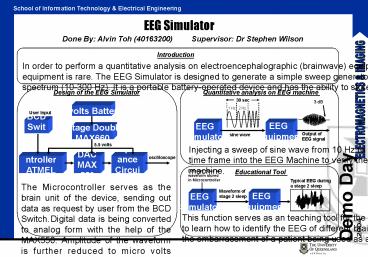EEG Simulator - PowerPoint PPT Presentation
1 / 1
Title:
EEG Simulator
Description:
In order to perform a quantitative analysis on electroencephalographic ... The EEG Simulator is designed to generate a simple sweep generator at EEG ... oscilloscope ... – PowerPoint PPT presentation
Number of Views:747
Avg rating:3.0/5.0
Title: EEG Simulator
1
EEG Simulator
Done By Alvin Toh (40163200) Supervisor Dr
Stephen Wilson
Introduction In order to perform
a quantitative analysis on electroencephalographic
(brainwave) equipment it is essential a known
source is used. Such equipment is rare. The EEG
Simulator is designed to generate a simple sweep
generator at EEG amplitudes (uVolts) and cover
the likely spectrum (10-300 Hz). It is a
portable battery-operated device and has the
ability to store other interesting waveforms for
teaching purposes.
Design of the EEG Simulator
Quantitative analysis on EEG machine
30 sec
3 dB
1 Hz
2 Hz
3 volts Battery
User Input
BCD Switch
EEG Simulator
EEG Equipment
Voltage Doubler MAX660
Output of EEG signal
sine wave
5.5 volts
Injecting a sweep of sine wave from 10 Hz to 300
Hz at 30 sec time frame into the EEG Machine to
verify the filter roll-off of the machine.
oscilloscope
Microcontroller ATMEL 90S8535
DAC MAX 550
Impedance Circuit
Educational Tool
Different types of waveform stored in
Microcontroller
Typical EEG during a stage 2 sleep
Impedance Circuit
The Microcontroller serves as the brain unit of
the device, sending out data as request by user
from the BCD Switch. Digital data is being
converted to analog form with the help of the
MAX550. Amplitude of the waveform is further
reduced to micro volts through the Impedance
Circuit. This portable device is powered-up by
two AAA batteries enhanced with a Voltage-Doubler
to provide adequate power for the various IC
chips.
Waveform of stage 2 sleep
EEG Simulator
EEG Equipment
This function serves as an teaching tool for the
technologists/students to learn how to identify
the EEG of different brain disease. It also
save the embarrassment of a patient being used as
a demonstration.































